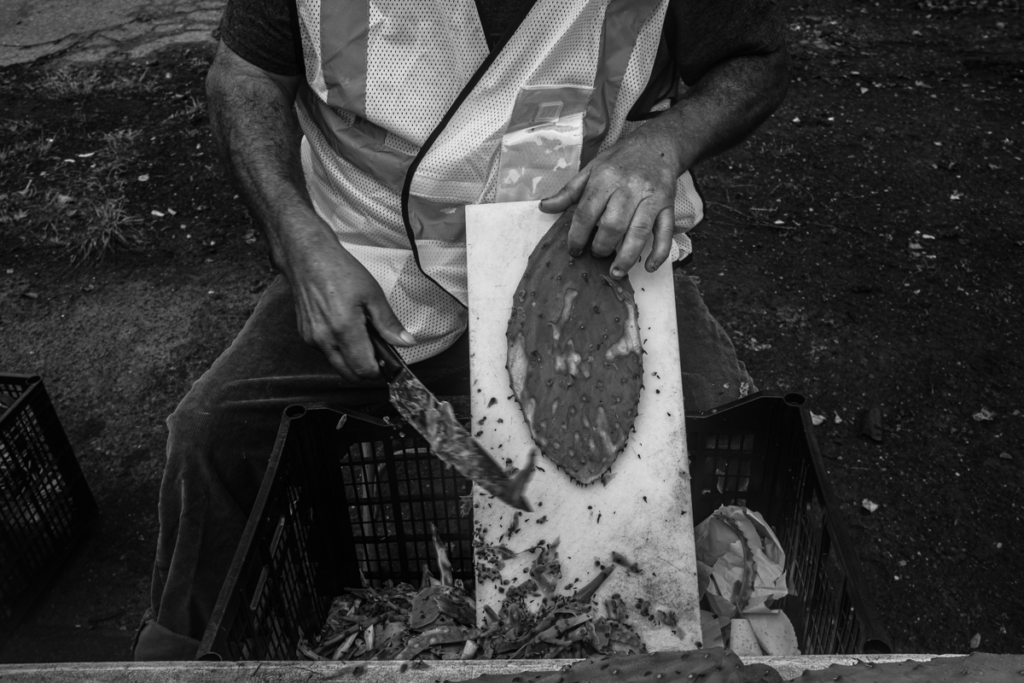Every day on his way to work, Steven Chavez passes by the newly constructed Target distribution center in Little Village. As he makes his way to I-55 to drive upwards of half an hour to his seasonal landscaping job in Hyde Park, he is reminded that a job at the distribution center would mean a shorter commute time, better wages and the possibility of health benefits, which he currently lives without.
So when the opportunity came, he took the time to update his resume and immediately applied for the warehouse operations position. On August 5, he filled out the application in English, a primary language for the Mexican-American who has been living in Little Village for two years.
Chavez says he has more than ten years of experience working in a warehouse, including six years of work in a facility vulcanizing semi truck tires and three years at Chicago Block and Brick, where he operated a forklift. So Chavez was confident his application would result in a hire. His hopes slowly started to dwindle as weeks passed with no response from Target. Six weeks after applying, he received an email that his application was denied.
“I was kind of shocked,” Chavez said. “I had been doing that kind of work for ten years or more. I’m qualified for forklift and working on machines. To get that email, I was kind of surprised.”
If Chavez’s application resulted in a hire, his would be just one of up to 2,000 jobs that Target has promised. Available positions include warehouse operations starting at $18 an hour.
Chavez is also among a number of applicants who say they haven’t gotten a call back from Target. Activists in Little Village say that although Target has promised thousands of jobs at its new distribution center, a number of Spanish speaking applicants are not getting call-backs.
In March 2019, despite growing opposition from community members and leaders about increased truck traffic, the City Council approved a $19.7 million tax break for Hilco Redevelopment Partners to build the million-square-foot Target distribution warehouse in Little Village (the completed warehouse is 1.3 million square feet). For a community already struggling to pay the bills and put food on the table, activists say the promise of jobs is too often used to pass legislation that ends up burdening Black and brown communities with environmental pollution and poor air quality while those jobs never find their way to local residents.
In preparation for the distribution center, Hilco imploded a nearly 400-foot concrete smokestack at the former Crawford power plant on April 11 of last year. The botched procedure, overseen by The Chicago Department of Public Health (CDPH) and The Department of Buildings (DOB), sent a cloud of dust that blanketed over six blocks of homes in the Little Village neighborhood during Easter weekend in the middle of the COVID-19 pandemic.
In their quarterly report published on October 18, the Office of Inspector General concluded that an employee from the CDPH should be fired and two employees from DOB should be disciplined for the mismanaged implosion.
“If [the Target warehouse is] going to be here, fifty percent of the jobs need to go to 60623 and 60632” ZIP codes, Little Village Environmental Justice Organization’s Executive Director Kim Wasserman said outside of Target’s private ribbon-cutting ceremony in July. “Why is it that we have this warehouse, our folks cannot even get the jobs here?”
Target’s first community meeting on August 31 confirmed that over 700 employees have been hired at the distribution center since recruitment began in spring and that about 112 individuals, or sixteen percent, of those hired reside in the Little Village 60623 ZIP code. None of the hired workers are temporary.
The new Target facility currently sits atop the site of the Crawford coal-fired power plant that activists fought for twelve years to shut down. A Harvard School of Public Health study found that forty-one premature deaths, 2,800 asthma attacks and 550 emergency room visits each year were linked to emissions from the two coal plants in Southwest Chicago—the Crawford plant in Little Village and another in Pilsen.

In the case of the new distribution center, activists say one pollutant is being replaced by another. Where there was once concern of coal as a pollutant, now there are worries about the amount of diesel fumes emitted into the air by trucks. Activists from LVEJO initiated their own survey of truck traffic on Pulaski and 31st and say they’ve counted an average of two diesel trucks per minute.
“Our goal is to make sure that we’re continually supporting the community and leveraging the community to improve both our business as well as the surrounding area,” Allen Brown, the senior distribution director at the facility, said during Target’s first community meeting on August 31.
Along with the promise of jobs, Target partnered with Central States SER and Instituto del Progreso Latino to host two job fairs during the first week of August. City Bureau attended one of the fairs and met a number of prospective applicants who were dismayed at the lack of engagement during the event. One applicant described the experience as an “application fair” where attendants were handed instructions to go online and fill out an application. Others who had already applied said they were told to look for a followup email in a couple of weeks.
Alderperson Michael Rodriguez (22nd Ward) considered the job fairs productive and said he’s received reports that over 100 people applied. And while he doesn’t know if any of those applicants received callbacks, he is “very hopeful that many folks who signed up at the job fairs will obtain employment.”
“From what I understand, it takes several weeks for Target to process folks,” he said.
A City Bureau reporter applied for the warehouse operations position on August 2, and received an offer of employment one week later without interviewing for the position.
At the community meeting, Brown said that the two job fairs resulted in the hiring of “some very talented employees that reside right here in the Little Village neighborhood,” but was unable to share specific numbers.
Sara Heymann, a member of Únete La Villita, a grassroots organization engaging residents around issues of housing, civic involvement and community-led development, has been working with residents struggling to stay in their homes after the statewide pandemic-induced eviction moratorium ended on October 3. She said the same people who are often struggling to pay for their rent are the same ones looking for jobs. Several months ago, she helped four people fill out Target applications online. She said none of them have gotten a call back from the distribution center.
Heymann was not aware the application was available in Spanish. For someone who describes herself as proficient with the computer and the internet, she was surprised that she missed the option of a Spanish version. She also described the application as long and confusing.
“There was this testing portion of [the application] that was super confusing even for me as I was helping them,” said Heymann. “And I consider myself a pretty competent person … and English is my first language. It was extremely confusing.”
Besides needing help accessing the application online, she said applicants also struggled with understanding the meaning behind a lot of the behavioral personality questions.
“Just the way the questions were being asked,” she said. “[Applicants] were like, ’What do they mean by that?’ They’re just trying to figure out basically do you talk with your coworkers while you’re working. They’re just trying to see if you’ll be a good worker.”
Chavez, who had not taken a personality test for employment before, said he had no issues filling out that portion of the application.
“I was fairly confident answering all the questions,” he said. “Like any other warehouse, safety procedures, helping others, I already know how that stuff kind of goes.”

Serving as one of the main entry points for Mexican families into the Midwest during the 1970s, Little Village has seen its Latino population stay strong. Today, the community on Chicago’s southwest side is home to a predominantly multi-generational Mexican American population.
When Mexicans arrived in Chicago in the 1970s, they confronted a changing industrial landscape and declining industrial employment. Where earlier waves of European immigrants had found higher-paying, unionized industrial jobs, Spanish speaking migrants were left with lower-wage nonunion manufacturing and service jobs. By 1970, about fifty-six percent of Latinos worked in manufacturing compared to only thirty percent of the rest of the city.
The need for work in Little Village is still apparent. As the number of jobs in the Little Village industrial corridor increased, residents experienced unemployment rates nearly double the countywide average between 2015-2019. A recent study also detailed how communities experiencing heavy burdens of environmental pollutants are largely low-income and communities of color.
Javier Garibay, executive director at Central States SER, says that besides getting a job, Little Village residents experience two issues when it comes to employment: the amount of travel time to work, often upwards of an hour each way, and finding child care during working hours.
Alderperson Rodriguez agrees that travel time to work and a consistent work schedule are some of the driving factors of quality of life and the main contributors to work equity, a cause he says he championed through his co-sponsorship of the Fair Workweek Ordinance.
“Predictive scheduling, primarily for Black and brown women, I think that’s something that we care a lot about in our community,” Rodriguez said. “And something we’re working toward heavily.”
Yet many Little Village residents still have to drive out to the suburbs for temporary warehouse jobs. And often, their schedules change with little notice. For those who have opted to apply to the new distribution center, activists say filling out the application in English was difficult. And while they’ve managed to fill out the application with the help of community activists and leaders, many of them are not moving along in the application process.
“What we know is people have reached out to us to say, ’I don’t speak English. I applied to a job, and nobody called me back.’ We’ve heard tons of stories in that regard,” Wasserman said in an interview after Target’s private ribbon cutting ceremony. “Why aren’t people getting hired? Specifically, why aren’t Spanish speaking people being called back if you know that that’s who lives in our neighborhood?”
A Target representative declined to comment on the challenges residents may face when filling out the online application.
Since the first official zoning ordinance in 1923, the city of Chicago has been concentrating industrial activity in key areas of the city. Usually near waterways and rail systems, these areas now form the city’s industrial framework.
Chicago has a total of twenty-six designated industrial corridors that criss-cross approximately twelve percent of the city’s footprint. One such industrial corridor is located in Little Village and encompasses 1,252 acres along the Sanitary and Ship Canal and Stevenson Expressway (I-55).
The Little Village industrial corridor is also part of the first group of corridors to undergo an overhauling land use and zoning review under the city’s 2016 Industrial Corridor Modernization Initiative, which places all corridors under scrutiny by city officials, industrial manufacturers and business stakeholders.
As it stands today, the City’s plans to rezone the Little Village industrial corridor is in draft form and comes with recommendations to revise the corridor’s boundaries and continue to expand manufacturing in the area. One of those expansions is Target’s distribution warehouse.
José Acosta-Córdova, LVEJO’s environmental planning and research organizer, says he expects more warehouses like the Target distribution center to take up residence in Little Village because facilities that operate in the same industrial sectors want to be near one another.
And warehousing along I-55 has particularly seen a boom in the last twenty years because it provides easy access to Chicago’s dense population, said Acosta-Córdova.
“The I-55 corridor is one of the busiest freight corridors in all of North America in terms of the amount of rail and the trucks that come through here,” he said.
For e-commerce companies like Target and Amazon, which is constructing its own 112,000 square foot distribution center in the Pilsen Industrial Corridor, being near a modern highway system means shorter travel times for drivers which means shorter wait times for customers.
“This last-mile logistics conversation is important because you can see these companies, they don’t want to be out in the middle of nowhere anymore because it still took them too long to get into the city,” Acosta-Córdova explained. “They want to be closer to where they can promise people next day delivery or same day delivery.”
That means people like Chavez may have more opportunities to apply for jobs as warehousing facilities open up. Whether he, along with other Little Village residents, gets a job at one of these warehouses remains to be seen.
“We’re supposed to be an immigrant-friendly city. Our community is built on the backs of immigrants,” Wasserman said. “Our economy is built on the backs of immigrants, yet people cannot get a job.”
Chavez says his current landscaping job will come to an end in the first couple weeks of December. Without a call back from Target, he will likely have to apply for unemployment till he resumes work in late March or early April.
With his resume still on file with Target, Chavez says he still has hopes that he’ll eventually get hired at the distribution center.
“I just wanted the opportunity and I’m sure a lot of people do,” he said. “It’d be a good job for people to better themselves and not kill themselves at the same time.”
Ata Younan is a multimedia storyteller covering culture and equity in Chicago. As a first-generation American Assyrian born in Iraq, she explores the nuance at the intersection of origin, culture, and identity. She is a 2021 City Bureau Reporting Fellow and contributing reporter at Borderless Magazine.This is her first piece for the Weekly.

